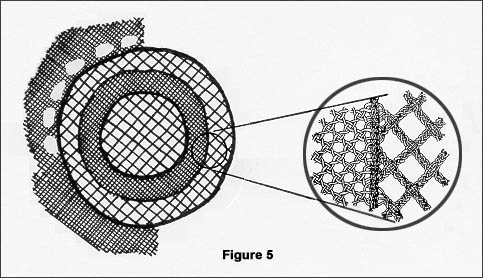by Penelope B. Drooker, Department of Anthropology, State University of New York
A frustration for archaeologists working in the humid climate of the southeast United States is that, in spite of the fact that these items were made in great numbers, perishable artifacts such as woodcarvings, baskets, and textiles rarely survive. Fortunately for those of us interested in textiles, a record does remain of fabrics used during the Mississippian period (ca. AD 900-1600), even though the textiles themselves are long gone.
During this time, large, shallow pottery vessels — up to a meter or more in diameter — were manufactured. Depressions dug in the ground were the molds for the vessels, but before introducing the clay into them, large textiles were placed in the shallow holes. These textile linings were used both to separate the vessels from their molds and also to slow down the drying time in order to prevent cracking. As a result, deep impressions of the fabrics were left on the outer surfaces of these vessels. Extremely detailed replicas of the textiles, right down to wisps of the fibers spun into yarn, can be obtained by pressing modeling clay into the surfaces of the pottery.
Many Tennessee archaeological sites have yielded large numbers of textile-impressed sherds. However, the yarns and fabrics shown on them have been analyzed for only a few locations, such as Hiwassee Island in Meigs County and Martin Farm in Monroe County. The McClung Museum curates collections from many of these sites. My own recent research involved the analysis of textiles impressed on pottery at the Stone site now in the Barkley Reservoir in Stewart County.
Like their counterparts elsewhere in the Southeast, women at Stone made wraparound skirts, mantles, blankets, and bags primarily by twining (two horizontal, or weft, yarns twist around each vertical, or warp, yarn [Figure 1], rather than by weaving (warp and weft yarns interlace over and under each other). They decorated their work by grouping weft rows in “stripe” designs [Figure 2], and by crossing and linking selected warp yarns between weft rows [Figures 3 and 4] which formed geometric designs made of “holes” in the plain-twined fabric. When these items were worn out, they were used in the pottery-making process.

Women at Stone also made very complex openwork fabrics, structurally analogous (except by their incorporation of twining) to European bobbin lace. An example that was pressed into ceramics reveals a design motif consisting of concentric circles of two different alternating openwork patterns [Figure 5].

The circular openwork areas are outlined by twining. No other fabrics like this one are known from pottery impressions, but two similar actual textiles have been recovered from elite graves at Spiro, Oklahoma, and Etowah, Georgia. The textiles most likely functioned as mantles, and they may well have been exchanged among high-status individuals of Mississippian society, as were other valued items. Why one of these intricate garments came to be pressed into a utilitarian pottery vessel at the Stone site we will never know, but we certainly are fortunate to have the evidence that it left behind.